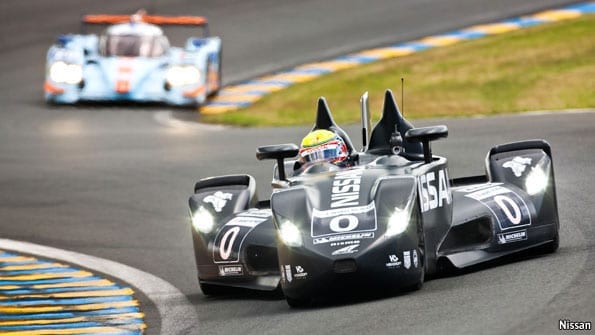The little DeltaWing car at this year’s Le Mans aimed to do things differently.
TO NO-ONE’S great surprise, Audi dominated last weekend’s 24-hour endurance race at Le Mans, in the bucolic Loire distict of France. A hybrid version of its R18 sports car once again took the chequered flag. Another Audi hybrid came second, and the company claimed third and fifth with a pair of turbo-diesels. Toyota returned to the race after a 13-year absence with two hybrids of its own—only to see one crash and the other retire with mechanical problems.
Though a novelty, the hybrids were not the stars of the show. A tiny triangular-shaped car known as the DeltaWing was giving the other 55 fire-breathing machines a run for their money when it was unceremoniously bumped off the track and into the crash barrier by one of the Toyotas. So ended a brave attempt to show that a car with half the weight, half the horsepower and half the aerodynamic drag could run rings round the dreadnoughts of the sport.
It was not the first time that a radical, lightweight design has challenged conventional thinking in motor racing. Something similar happened when Colin Chapman’s featherweight Lotus 23, with Jim Clark at the wheel, made its debut at the Nürburgring’s infamous northern loop in 1962. With its tiny 100 horsepower motor (a third that of its rivals), the Lotus 23 shot ahead of the field of ponderous Porsches, Aston Martins and Ferraris. After one lap of the rain-soaked track, Clark was 27 seconds ahead of the leading Porsche driven by the American ace, Dan Gurney. The world of motor racing had never seen anything like it before.
The following month, when two Lotus 23 cars—one with a 750cc engine and the other with a 1,000cc unit—were entered for the Le Mans endurance race, French officials promptly banned them for being too good. Chapman swore never to enter a Lotus car for the 24-hour Le Mans race ever again—and kept his promise till the day he died.
More than in any other motor sport, engineering improvements made to meet the gruelling demands of endurance racing feed directly into everyday motoring. Unlike Formula One cars or their IndyCar cousins, where teams focus on making vehicles that run furiously for a few hours, endurance events like Le Mans are more about building sporty but reliable machines that can run flat out for a full 24 hours, with only brief pit stops to take on fuel, replace worn tyres and swap drivers.
via The Economist
The Latest Streaming News: Shape of cars to come updated minute-by-minute









